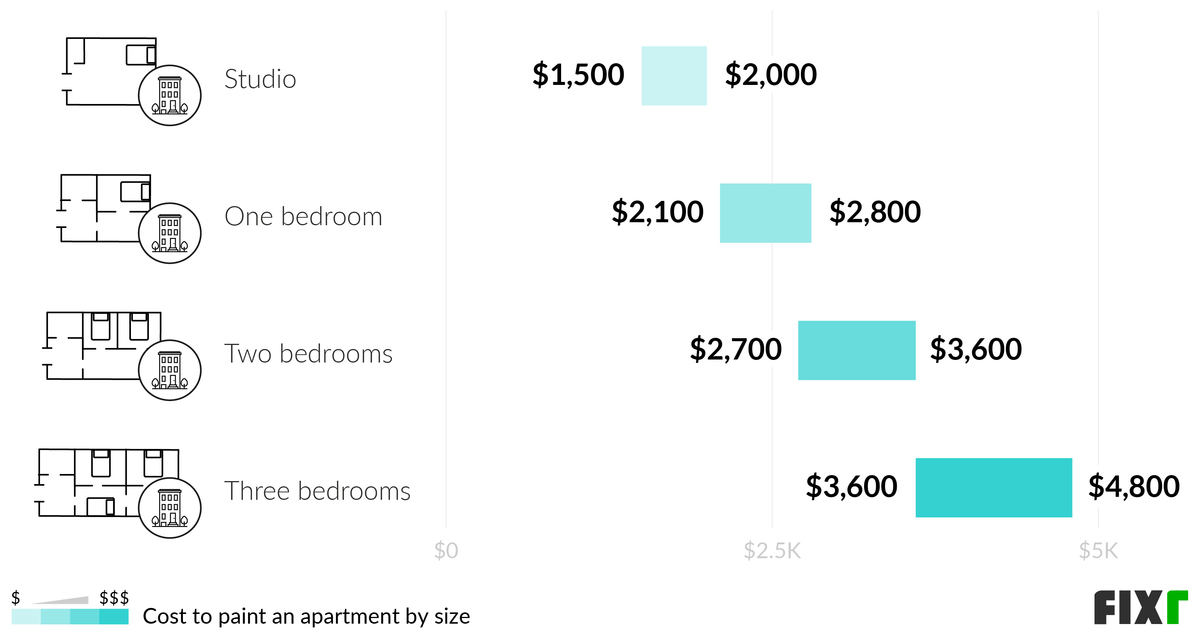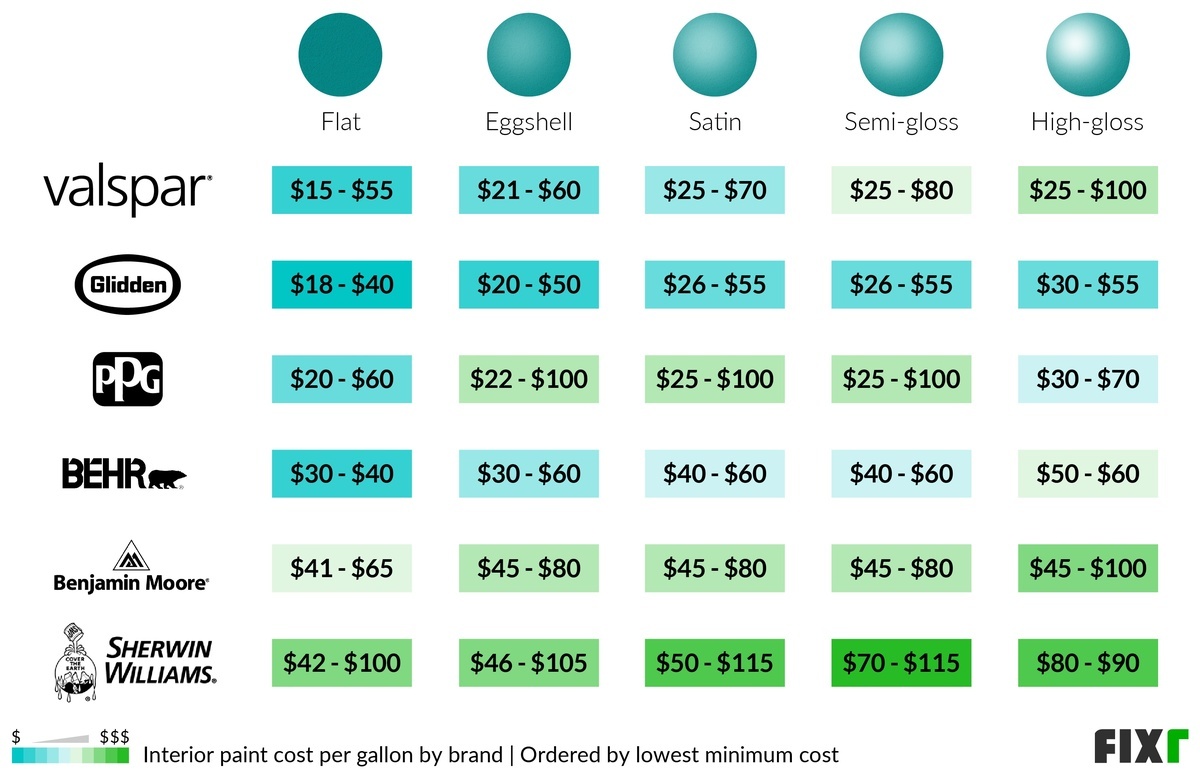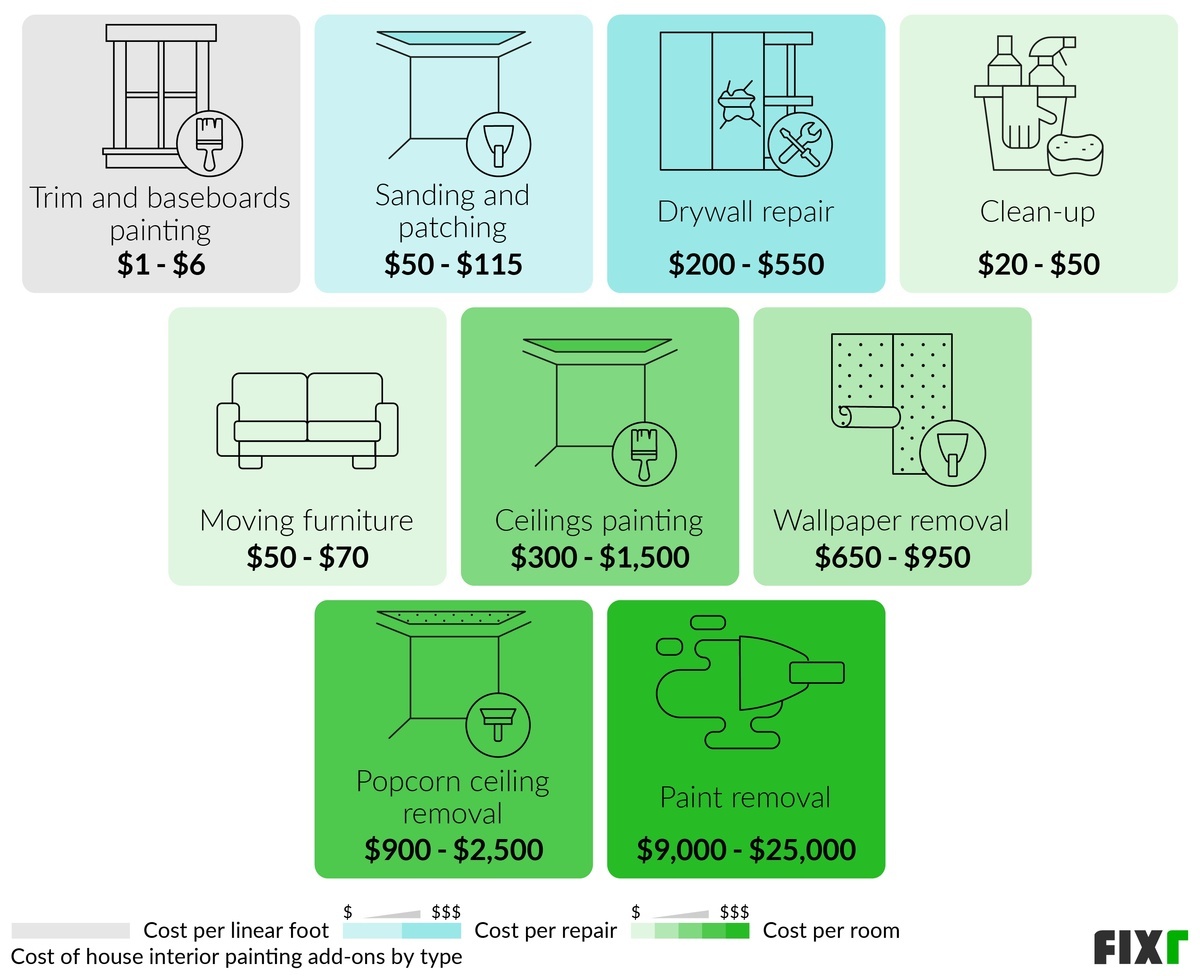How Much Does It Cost to Paint a House Interior?
Painting the interior of your home is a great way to revitalize your space with a fresh look. People paint their interiors to revive tired or dirty walls, match a new interior design, brighten a dark room, or visually change the scope of the area. Because many interiors follow a “color story,” or a cohesive color design throughout the home, it is not uncommon to paint the entirety of a home interior at once. Many factors impact the cost to paint the inside of a house, including how many rooms you are painting, the size of each room, and the paint type. With the rising cost of materials and inflation, many paint suppliers have increased costs or plan to increase prices in 2023 by 12% to 30% for paint, impacting project costs.
The national average cost to paint the interior of a home is $7,500 to $10,000, with most homeowners paying $8,700 to paint the walls and ceilings of an average 2,500 sq.ft. home using different colors. This project’s low cost is $450 to paint the walls and ceilings of a 300 sq.ft. room. The high cost is $16,000 to paint all the walls, ceilings, and trim work of a 4,000 sq.ft. home using different colors and custom applications.
Price to Paint a House Interior
| Interior House Painting Cost | |
|---|---|
| National average cost | $8,700 |
| Average range | $7,500-$10,000 |
| Low-end | $450 |
| High-end | $16,000 |
In this guide
Home Interior Painting Cost by House Type
Labor Cost for Interior Painting
Interior Wall Primer Price by Type
Interior Paint Cost by Brand
Factors That Affect the Cost to Paint a House Interior
Custom Interior Painting Price
Cost to Repaint the Interior of a House
New Construction Interior Painting Cost
Preparing Interior Walls for Painting
Best Interior Paint Colors
Add-On Costs
Cleaning Painted Walls
Enhancement and Improvement Costs
Additional Considerations
FAQs
House Painting Cost by Project Range
Interior Painting Cost per Sq.Ft.
For spaces ranging from 1,000 to 4,000 sq.ft., indoor painting costs average $3,000 to $16,000, or $3 to $4 a sq.ft. The average house size is 2,500 sq.ft., making the painting cost $7,500 to $10,000, assuming you paint the walls one coat of a single color. More coats of paint and multiple color changes may increase the costs per square foot to between $6 and $8 for complex jobs. Unless you change from a light to a dark color or vice versa, most painting jobs fall between $3 and $4 a sq.ft.
However, there are factors to consider when calculating the price per square foot to paint an interior space. In some cases, you need a primer 1 first and then paint, meaning you may need one gallon of primer and one gallon of paint to cover 400 sq.ft. However, if the wall requires multiple coats, this increases the total amount of square footage and paint required.
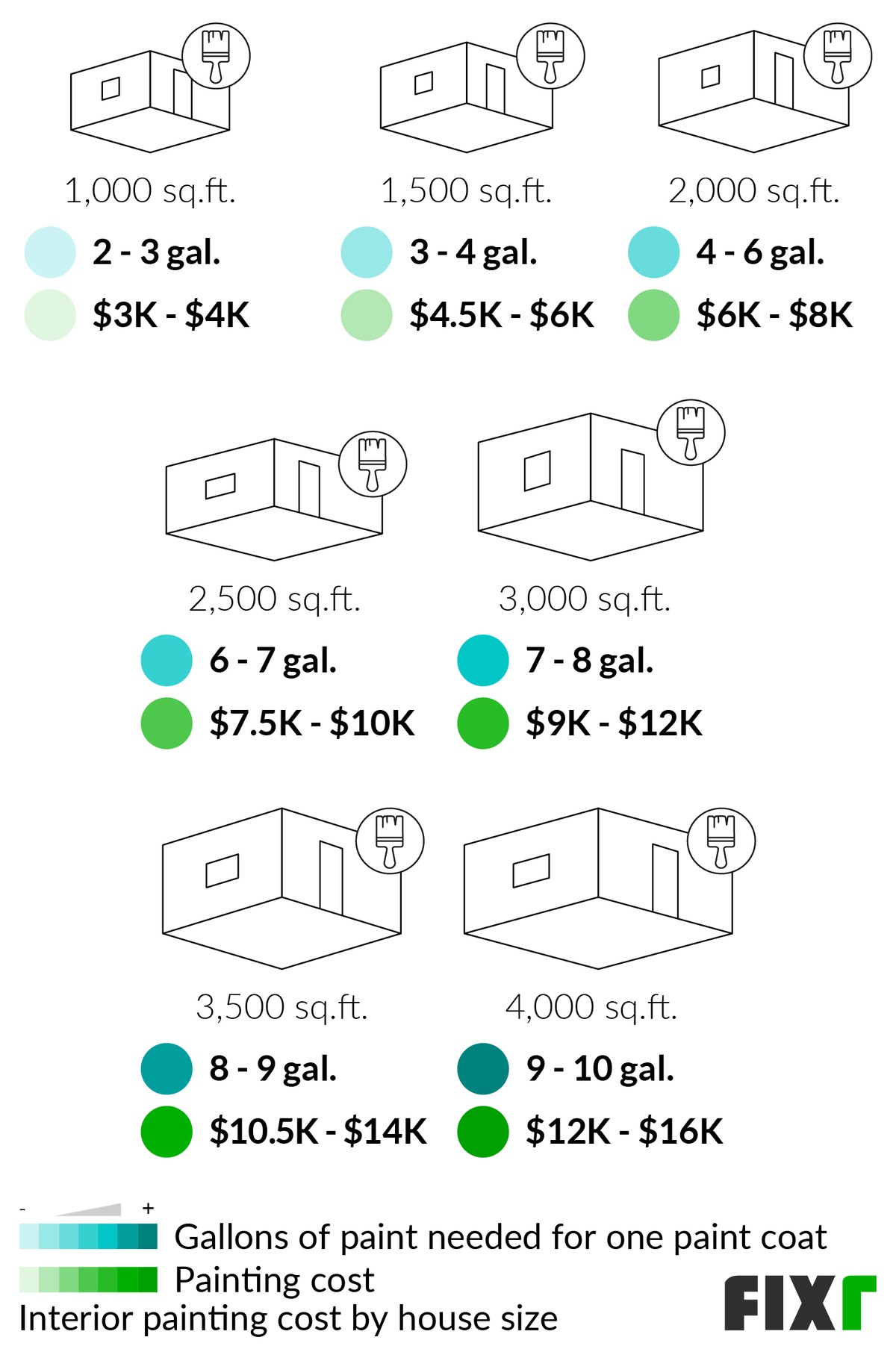
| Home Size | Gallons of Paint Needed (One Coat) | Cost (Labor Included) |
|---|---|---|
| 1,000 sq.ft. | 2 - 3 | $3,000 - $4,000 |
| 1,500 sq.ft. | 3 - 4 | $4,500 - $6,000 |
| 2,000 sq.ft. | 4 - 5 | $6,000 - $8,000 |
| 2,500 sq.ft. | 6 - 7 | $7,500 - $10,000 |
| 3,000 sq.ft. | 7 - 8 | $9,000 - $12,000 |
| 3,500 sq.ft. | 8 - 9 | $10,500 - $14,000 |
| 4,000 sq.ft. | 9 - 10 | $12,000 - $16,000 |
Average Cost to Paint a 1,000 Sq.Ft. House Interior
Between supplies and materials, you can expect to pay between $3,000 and $4,000 to paint a 1,000 sq.ft. house interior. You will need between two to three gallons of paint to complete one coat. This size home will generally have two bedrooms, a main living room, a kitchen, and a bathroom. The layout of your space impacts the overall cost of your project.
Cost to Paint a 1,500 Sq.Ft. House Interior
Between labor and materials, the average cost to professionally paint the interior of a 1,500 sq.ft. house ranges from $4,500 to $6,000. To complete one coat of paint throughout your entire space, you need between three and four gallons of paint. The overall cost of your project depends on the type of paint you use, the current state of your home, and the layout of your space as well.
Cost to Paint a 2,000 Sq.Ft. House Interior
You can expect to pay between $6,000 and $8,000 to paint a 2,000 sq.ft. house. You will need approximately five gallons to complete one coat. This size home is slightly under the current average home square footage, but it is still a substantial space with enough room for multiple bedrooms, a living room, one to two bathrooms, and a kitchen.
Cost to Paint a 2,500 Sq.Ft. House Interior
Painting a 2,500 sq.ft. house averages $7,500 to $10,000. You need to hire professional painters and use between six to seven gallons of paint. This is generally the size of an average home. Project prices vary depending on the complexity and if you paint the ceilings. Generally, homes of this size use several interior colors, making the painting process slow. Adding trim can also bump costs toward the high end.
Cost to Paint a 3,000 Sq.Ft. House Interior
You pay between $9,000 and $12,000 to paint the interior of a 3,000 sq.ft. house and need between seven and eight gallons of paint for one coat. This cost fluctuates based on many factors, including if you paint staircases, move large pieces of furniture, or paint ceilings. The number of colors and the trim amount also impact the project cost. Modern home interiors may fall on the lower end because they change colors less often, while more traditional homes may have higher costs.
Cost to Paint a 3,500 Sq.Ft. House Interior
To paint a 3,500 sq.ft. home interior, expect to use eight to nine gallons of paint and pay between $10,500 and $14,000. Overall, prices vary depending on your home’s layout and the complexity of each room. Some painters charge more if they have to move up and down stairs to paint. The more rooms the home has and the amount of trim also impact the total cost. The more color changes and taping that are necessary, the higher the cost.
Cost to Paint a 4,000 Sq.Ft. House Interior
Generally, you can expect to pay between $12,000 and $16,000 to paint a 4,000 sq.ft. home. To complete one coat of paint throughout the entire interior, you will need at least ten gallons of paint. Overall prices vary depending on if you need to remove paint beforehand or if you need to apply extra coats to cover your interior fully. As this is a larger home, it will take longer for painters to finish the job, affecting the overall price.
Home Interior Painting Cost by House Type
Interior paint jobs are different based on the space, ranging from $1,500 to $14,000. Whether you live in an apartment, condominium, house, or mobile home, you can paint your interior in many ways. The space size is always a factor because larger living spaces need more paint. Homes with stairs and many rooms cost more than open spaces, single-floor living spaces, and modern interiors. This leads to a range of costs for each home type. Below are the various living spaces and their average costs to paint.

| House Type | Painting Cost |
|---|---|
| Apartment | $1,500 - $4,800 |
| Condominium | $1,800 - $5,000 |
| Mobile Home | $2,000 - $4,200 |
| House | $3,000 - $14,000 |
Cost to Paint an Apartment
Painting the interior of an apartment costs between $1,500 and $4,800. Many people living in apartments rent, which can make it feel like there are limited options for redecorating. However, most landlords are fine with you painting your apartment if you change it back before you move out. The cost to paint your apartment varies based on how much space you have. A studio apartment offers approximately 500 sq.ft. of space. A three-bedroom apartment is usually about 1,200 sq.ft. The table below shows the pricing for the most common apartment sizes.

| Apartment Size | Painting Cost |
|---|---|
| Studio | $1,500 - $2,000 |
| One Bedroom | $2,100 - $2,800 |
| Two Bedrooms | $2,700 - $3,600 |
| Three Bedrooms | $3,600 - $4,800 |
Condo Painting Cost
When thinking about painting your condo, expect to pay between $1,800 and $5,000. The main difference between a condo and an apartment is that a condo is owned rather than rented. This means you are more likely to have more colors, can make changes from light to dark or dark to light, or have more trim, making costs slightly higher in condos. Like apartments, the more individual rooms, the higher the cost, so the cost to paint a two-bedroom condo can be higher than a single bedroom, but there can be overlap depending on the size. They generally range from 600 to 1,300 sq.ft. Because condos are smaller than the average home, it is a good idea to use colors that catch the light and open your space.

| Condo Size | Painting Cost |
|---|---|
| One Bedroom | $1,800 - $2,800 |
| Two Bedrooms | $2,700 - $3,600 |
| Three Bedrooms | $3,700 - $5,000 |
Painting a Mobile House Interior
If you are looking for a great way to make your space your own, painting the interior is a great place to start. This costs between $2,000 and $4,200. Most manufactured homes feature vinyl-on-gypsum (VOG) wall panels, which can easily be painted. This material is similar to drywall 2 in many ways, but the seams of VOG walls are covered by plastic strips. Use high-quality paint and primer when painting the interior of your mobile home because cheaper paints are more prone to flaking on vinyl walls. Mobile homes come in many sizes, usually grouped by width - with single-wide, double-wide, and triple-wide being available. For some very large triple-wides, your costs could begin to approach the costs of a single-family home due to the size.
Cost to Paint a Single-Family House
The cost to professionally paint an entire house interior varies based on the house size, ranging from $3,000 to $14,000. The bigger the house, the more expensive the paint job. The average two-bedroom single-family home is about 1,000 sq.ft. A five-bedroom house can exceed 3,000 sq.ft., so the cost to paint a two-bedroom house is lower than the cost to paint a five-bedroom house, regardless of the style, layout, and color changes. Other factors impact the project’s cost, including the shape of the rooms you paint and the features inside them. Typically, larger homes use more paint colors, increasing the project cost. The room types can also impact costs because some rooms may have more trim, heavier furniture, and other features. Below are the average costs to paint a home based on the number of bedrooms.

| House Size | Painting Cost |
|---|---|
| Two Bedrooms | $3,000 - $4,000 |
| Three Bedrooms | $4,700 - $6,200 |
| Four Bedrooms | $7,000 - $9,000 |
| Five Bedrooms | $10,000 - $14,000 |
Labor Cost for Interior Painting
A professional house painter usually does this job, so it is important to know the average interior painter’s cost. Your painting contractor assesses the walls, cleans, makes necessary repairs, or removes old wall coverings. They also tape off adjacent surfaces and cover nearby furniture and floors with drop cloths to ensure nothing gets ruined during the process. Typically, professional painters apply a layer of primer followed by one to three coats of paint, depending on the color and coverage. Once the paint is dry, they take a final walkthrough to inspect and make necessary touch-ups.
The labor cost to repaint interior walls varies depending on how each contractor charges. While many painters charge per sq.ft., some set their interior paint cost based on the number of rooms or hours. The average labor cost for interior painting varies depending on the work scope. Typically, interior painting labor cost per sq.ft. ranges from $2 to $6, $25 to $100 an hour, or $400 to $2,000 per room, depending on the size and whether all the room surfaces are painted or just the walls.

| Rate Type | Cost |
|---|---|
| Per Square Foot | $2 - $6 |
| Per Hour | $25 - $100 |
| Per Room | $400 - $2,000 |
Interior Wall Primer Price by Type
While you can paint over paint, some colors and paints do better over a primer or material that prepares the surface to receive the paint. If you switch paint types, such as going from oil to latex, primer ensures the new paint adheres without cracking or peeling. There are a few primer types. They are directly related to the paint type you use and the surface you are painting, and their costs per gallon vary, ranging from $15 to $80 per gallon.
Oil-based primers are good for painting on wood and work with oil and latex-based paints. They prevent stains from bleeding through the new paint. However, oil-based paints and primers are illegal in some states. Latex-based primers are good for drywall and work with latex paints. They can cover and seal small stains. Shellac primers are good for wood and covering major damage from smoke and water. They can seal in the smell of smoke and any staining, although they may be used in spot treatments due to VOCs and higher costs. Below are the average costs per gallon for the various primer types.

| Primer Type | Cost per Gallon (Materials Only) |
|---|---|
| Latex | $15 - $60 |
| Oil | $25 - $70 |
| Shellac | $30 - $80 |
Interior Paint Cost by Brand
A wide range of paint brands can be a good fit for your interior painting project, each with a cost range and color set. Depending on the brand and finish type, your interior paint cost per gallon is between $15 and $100 for flat paint, $20 and $105 for eggshell paint, $25 and $115 for satin paint, $25 and $115 for semi-gloss paint, and $25 and $100 for high-gloss paint. Typically, each brand offers a high-quality and mid-range paint and many colors and finishes. Depending on which you choose, you can estimate your overall indoor paint prices per gallon.
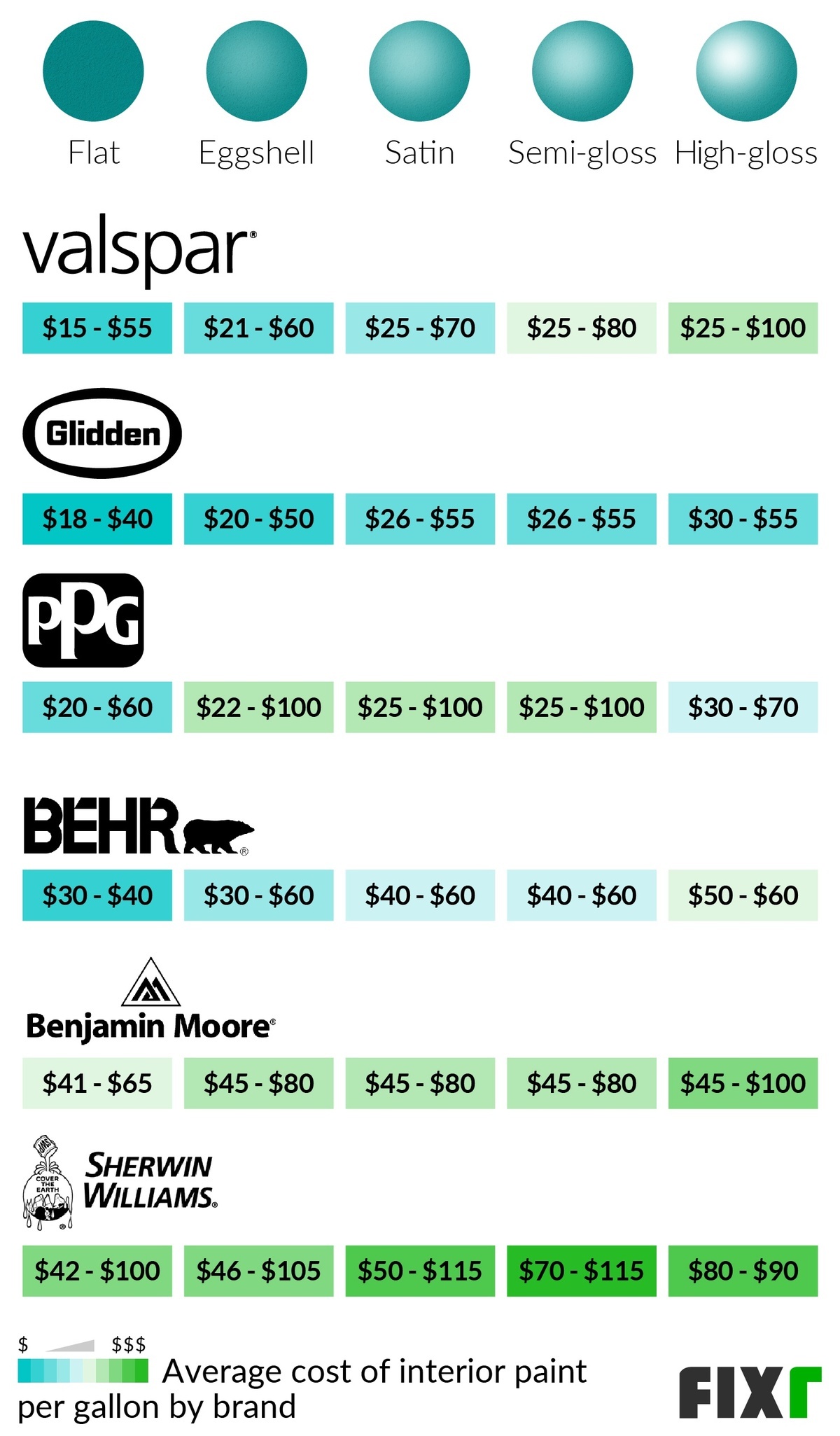
Valspar Paint Cost
Valspar offers a Signature Colors paint collection that is durable and low-maintenance. Their paints cost between $15 and $100 per gallon. They offer affordable interior paints and paint and primer products, making the renovating process quicker. They boast approximately 1,200 unique colors and various finishes.
| Paint Type | Cost (Materials Only) |
|---|---|
| Flat | $15 - $55 |
| Eggshell | $21 - $60 |
| Satin | $25 - $70 |
| Semi-Gloss | $25 - $80 |
| High-Gloss | $25 - $100 |
Glidden Paint Cost
Glidden is an inexpensive interior paint brand with paints ranging from $18 to $55 per gallon. This brand can be found mainly in Walmart stores across the country. While it lacks the obvious name recognition of Behr and Sherwin-Williams, it consistently receives great reviews from homeowners and painting contractors. Most Glidden paints are mold and mildew-resistant, making them a great choice for kitchens and bathrooms.
| Paint Type | Cost (Materials Only) |
|---|---|
| Flat | $18 - $40 |
| Eggshell | $20 - $50 |
| Satin | $26 - $55 |
| Semi-Gloss | $26 - $55 |
| High-Gloss | $30 - $55 |
PPG Paint Cost
PPG Interior Paints has over 135 years of experience in the painting business. Depending on the paint type, expect to pay $20 to $70 per gallon. As a global supplier of high-quality paints, they offer many unique colors for every room, including metallics and wood stain colors. They also have paint and primer products that offer quality, performance, and durability. PPG paints are especially useful for painting older rooms because they can easily cover smoke and water residue.
| Paint Type | Cost (Materials Only) |
|---|---|
| Flat | $20 - $60 |
| Eggshell | $22 - $100 |
| Satin | $25 - $100 |
| Semi-Gloss | $25 - $100 |
| High-Gloss | $30 - $70 |
Behr Paint Cost
Behr has been a Home Depot paint brand since 1978. They offer a range of interior paints suitable for everyday painting projects and high-end jobs. The cost ranges from $30 to $60 per gallon. Behr paint is thicker, which helps with coverage but may make it difficult for intricate custom work. Because the paint is thicker, it takes slightly longer to dry.
| Type of Paint | Cost (Materials Only) |
|---|---|
| Flat | $30 - $40 |
| Eggshell | $30 - $60 |
| Satin | $40 - $60 |
| Semi-Gloss | $40 - $60 |
| High-Gloss | $50 - $60 |
Benjamin Moore Paint Price
Benjamin Moore is a great choice for interior paint because they offer high-quality products at a good price. It costs $41 to $100 per gallon, based on the finish type. Rather than working as a major corporation, each store is locally owned, which can be a big plus for many homeowners looking for a brand to trust. While they offer a range of affordable paints, their high-end options are pricey but reliable and durable.
| Paint Type | Cost (Materials Only) |
|---|---|
| Flat | $41 - $65 |
| Eggshell | $45 - $80 |
| Satin | $45 - $80 |
| Semi-Gloss | $45 - $80 |
| High-Gloss | $45 - $100 |
Sherwin Williams Paint Prices
Sherwin-Williams has stores across the nation and offers various basic and self-priming paints, ranging from $42 to $115 per gallon. Most of their painting products are easy to brush and roll onto walls and ceilings, making them a convenient and trustworthy choice for interior painting projects. Sherwin-Williams paint is thinner, so it dries quicker. However, that means you may need multiple coats.
| Type of Paint | Cost (Materials Only) |
|---|---|
| Flat | $42 - $100 |
| Eggshell | $46 - $105 |
| Satin | $50 - $115 |
| Semi-Gloss | $70 - $115 |
| High-Gloss | $80 - $90 |
Factors That Affect the Cost to Paint a House Interior
Several factors determine the project’s final price. When estimating the total cost of your interior painting project, it is important to consider the different aspects.
- Number of coats. The number of coats impacts cost. Each coat needs time to dry and increases material and labor costs.
- Type of paint. High-quality paints cost more than standard paints. Low-VOC paints cost more, and oil-based paints cost more and take longer to dry, so they cost more in labor.
- Changing colors. If you change colors between rooms, your costs are likely higher than if you use one color throughout. Changing colors means purchasing smaller quantities of several paints, increasing costs. Time must be taken to clean brushes and other equipment between rooms, increasing labor costs.
- Wall texture. Highly textured walls may need special equipment, increasing labor costs for the project.
- Wall condition. Painters may have to patch holes, repair drywall, and remove wallpaper, which further drives your project’s cost.
- Complexity. High ceilings, accent walls, faux finishes, ornate trim, and other complex areas increase the labor needed, raising the project’s cost.
Adding ceilings increases labor since it requires additional masking, cover-up, and paint. Also consider whether the ceiling will be a different color than the walls as this would require the wall to be cut-in, which would add another 20% to labor costs. Your cost would be more than double if you add baseboards, doors, and other trim. Millwork usually requires spraying, which would further increase labor time; sanding, dust extraction, air-tight masking, multiple coats and drying time between coats.
Custom Interior Painting Price
While many paint all the walls in a room a single color, you can also paint each in different styles, costing $70 to $500. These include using an accent wall, two-tone walls, patterns or stencils to create decorative elements on the walls, painting a mural, or using faux painting techniques, such as sponging. Painting one wall a different color from the rest of the room - an accent wall - is the least expensive, depending on the color and number of coats, followed by painting walls using two colors. Murals and faux painting are the most expensive to add, and costs range depending on the complexity.
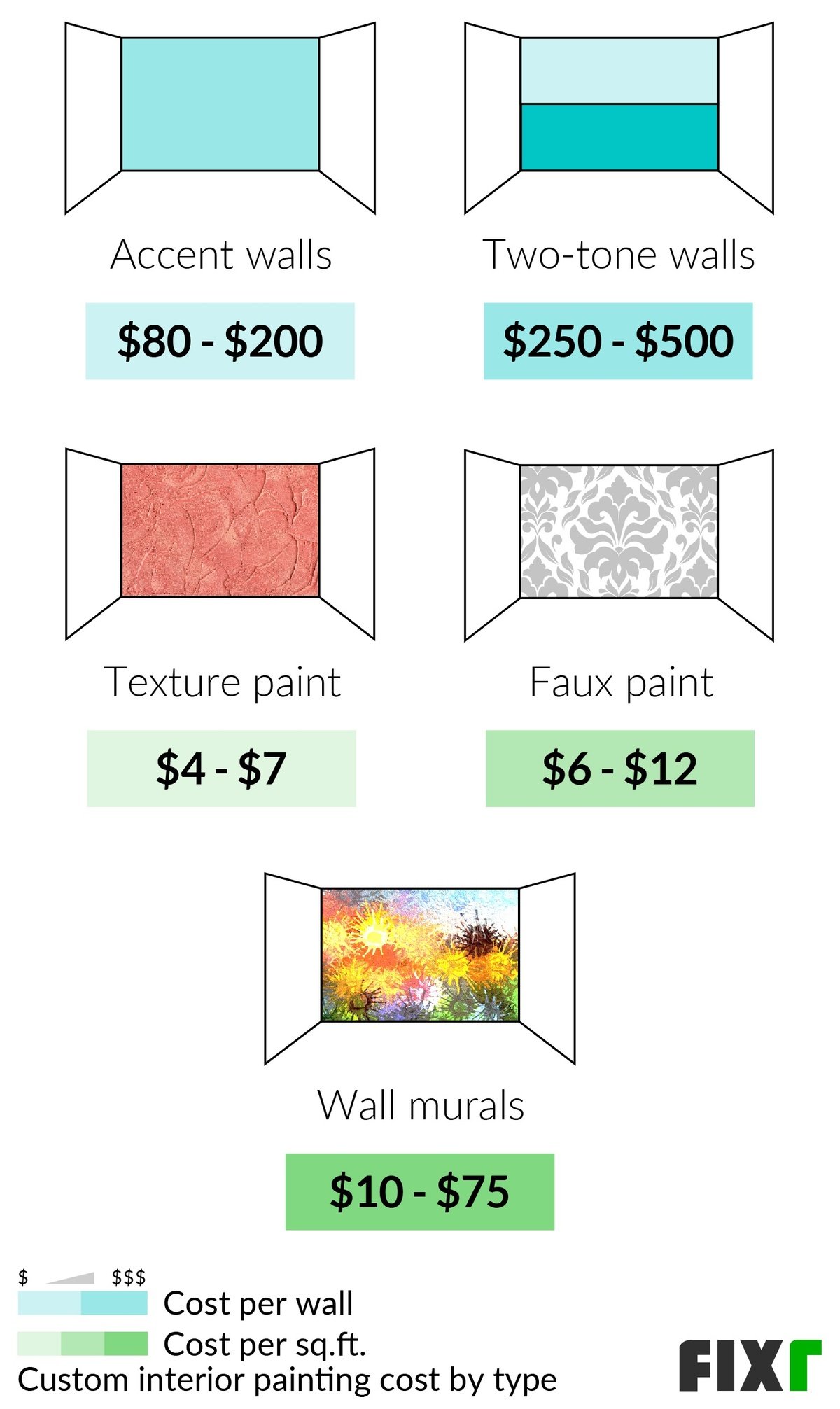
| Custom Style | Painting Cost |
|---|---|
| Accent Walls | $80 - $200/wall |
| Two-Tone Walls | $250 - $500/wall |
| Texture Paint | $4 - $7/sq.ft. |
| Faux Paint | $6 - $12/sq.ft. |
| Wall Murals | $10 - $75/sq.ft. |
Cost to Paint an Accent Wall
An accent wall is a single wall that looks different from the rest. It costs $80 to $200 to paint one. If you have a room without noticeable architectural features, painting an accent wall is a great way to spruce up your space. An accent wall should be highly visible and draw people’s attention. You have unlimited options when choosing colors, but remember to use that same color throughout decorative features in your home like pillows, rugs, and furniture.
Paint a Two-Tone Wall
Two-tone walls offer homeowners a great chance to step outside their comfort zones. Rather than relying on a single color, the lower half of the wall is painted differently from the upper half. This is more expensive, ranging from $250 to $500 per wall, than painting a wall one color because you use multiple paint cans. Plus, the painters have to be more careful when applying the paint. When considering painting styles, understand how the colors interact with one another and the room.
Texture Painting Price
Painting textured walls is challenging but possible. It costs $4 to $7 per sq.ft. Your painters need special tools to do this correctly, such as rough surface painter’s tape, angled brushes, nap rollers, and masonry paint. For best results, make sure the surface is clear of dirt or mildew. They also must peel away old, flaky paint before starting, which could take more time and increase the cost
Faux Painting Cost
Faux painting techniques mimic the finish of other materials, including fabric, wood, and granite. It is generally more expensive than your basic interior painting job, ranging from $6 to $12 per sq.ft. By using this painting technique, you can add dimension to your home and completely change the interior. Costs for faux painting vary depending on the style and complexity. Some faux painting must be done in layers, increasing costs, while others may be done at once for less.
Wall Mural Painting Cost
Painting a mural on your wall involves an extra level of intricacy that ends up costing you. Most mural painters charge between $10 to $75 per sq.ft. to paint a mural, depending on their experience level and the design complexity. Have a concrete idea of your vision so that you can work closely with your painter to make it come to life.
Cost to Repaint the Interior of a House
If you plan to repaint your home, you may have to take a few extra steps. Depending on the state of your walls and current color, you probably need to add a layer of primer first. That way, you can be sure the new color shines without the old showing underneath. For the average 2,500 sq.ft. house, expect to pay between $7,700 and $10,500 with the primer layer. However, if you are going from very dark to very light, you may need additional coats, which can increase costs to between $8,000 and $12,000 for a 2,500 sq.ft. home.
Another option is to completely remove the paint off your walls, though this is much more costly. Generally, you only need to remove old paint if it is flaking, curling, or not properly adhering. Between removing the old paint and repainting, costs range from $16,500 to $35,000 for a 2,500 sq.ft. home.
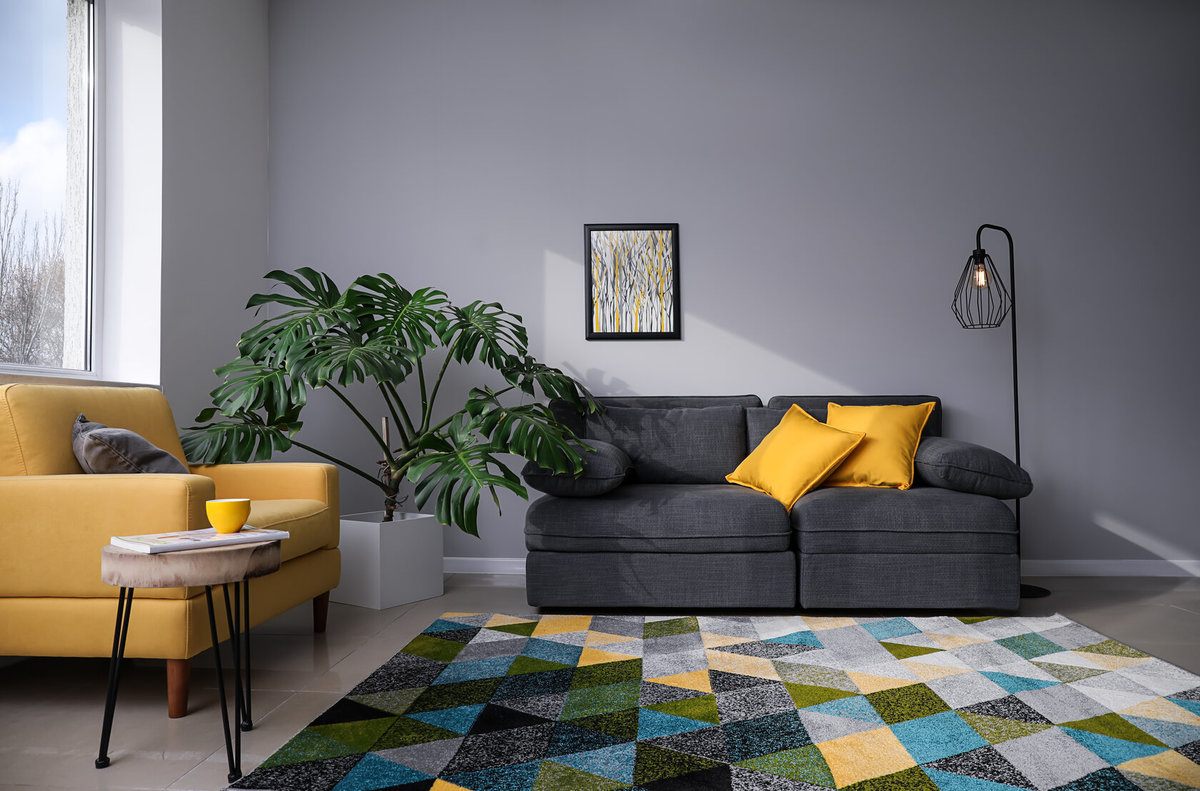
New Construction Interior Painting Cost
When it comes to new construction, painters come into the picture after the plumbing, electrical, and drywall work have been completed. However, nothing else is in the house yet, making the job much simpler. Because there is no flooring, cabinetry, trim work, lighting fixtures, or other features, the painters do not have to worry about lengthy preparations or extensive cleanup. Because of this, painting new construction is slightly less expensive than a lived-in home. Costs range from $7,000 to $9,500.
Preparing Interior Walls for Painting
Before you can paint your interior, you have to do a few things to prepare your space. Some of these preparations may be included in your contractors’ painting fee, but you can also do some of the work yourself. If you plan on doing things yourself, have everything prepared before the painters arrive. Otherwise, you are wasting their time and potentially adding expenses to your project.
Some pre-painting tasks include moving furniture from the walls, covering furniture and flooring, taping off areas, removing knobs and other hardware, filling holes in drywall, and cleaning them. It is a good idea to clear pictures, vases, and other knick-knacks so that they do not get in the painters’ way. Plus, this ensures your belongings stay safe.
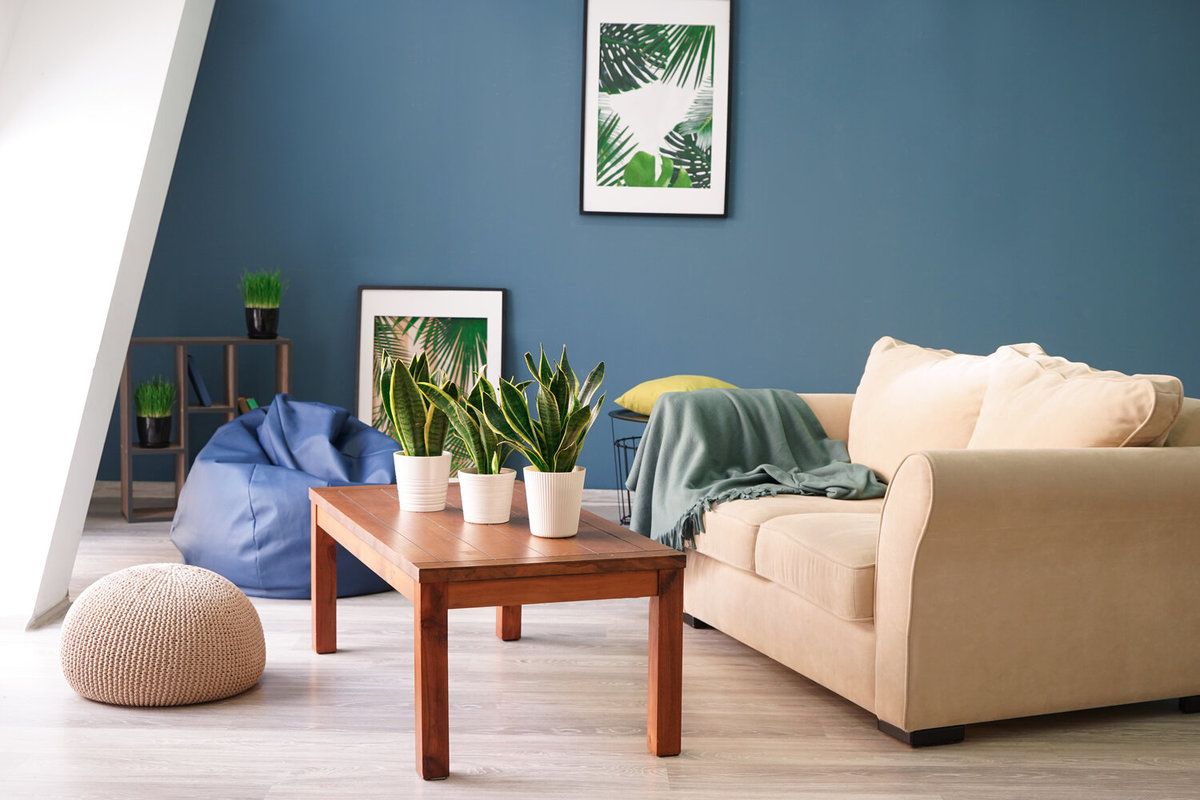
Best Interior Paint Colors
Color is always the first consideration when painting a home. Most paint manufacturers offer samples, so you can make an informed decision before painting. While it can be tempting to simply paint the sample right onto the wall, this may not get you the most accurate results. Instead, consider painting a piece of poster board or another material you can move. This allows you to look at the paint on different walls and areas throughout the day and night to see how light changes it. Look at the paint in each area for at least 24 hours to ensure you like it.
Color impacts how a room appears in many ways. Light colors may help brighten a darker space. Cool colors recede visually from the eye and make a small space appear bigger. Warm colors contract visually, making larger spaces appear smaller or cozier. Combining cool and warm tones in one room, like with accent walls, can visually change the room’s shape, making rectangles look more like squares. There are many combinations you can use to suit your space.
Terracotta tops the list of this year’s most popular paint colors for interiors. While warm neutrals and earthy tone palettes continue to be popular, homeowners are also more willing to choose neutral colors with pops of bold color, as these are the perfect accent to neutral shades. In 2023, wallpaper will continue to be a big trend, with botanical patterns being the top choice.
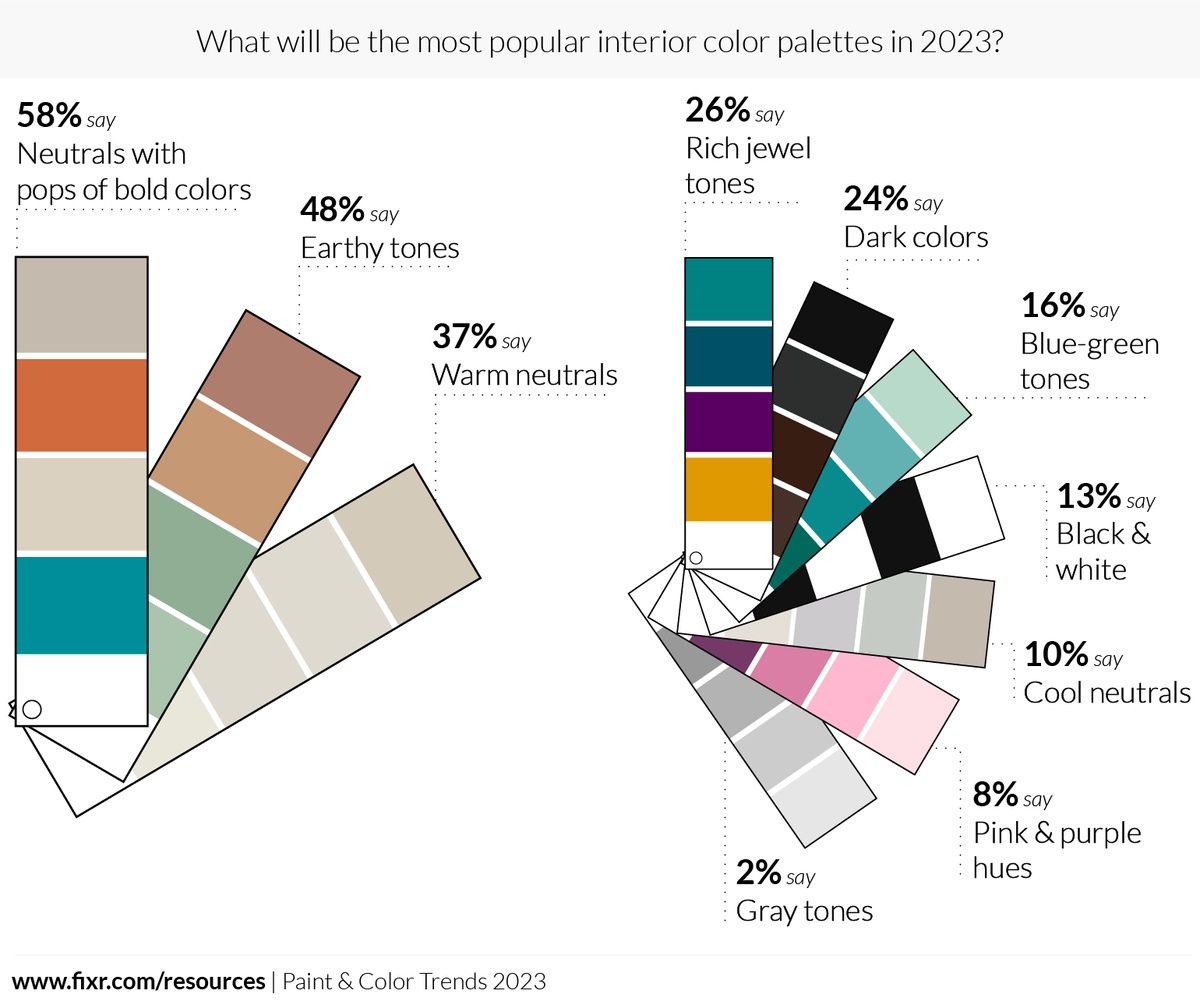
Add-On Costs
No two interior paint jobs are alike. It is important to analyze the overall state of your space before starting. If you paint your ceiling, trim, and baseboards, there is a chance you may need to take a few extra steps to prepare your space. This includes removing popcorn ceiling, moving furniture from the walls, repairing drywall, and cleaning your baseboards and trim. You may also want to paint doors and caulk windows, adding more to your project.
Removing old paint or wallpaper before painting also increases the total cost, which can vary depending on your home’s condition. There is plenty of cleanup to deal with after the paint job is done. While you can take care of it on your own, most paint contractors offer cleanup services.

| Add-On Project | Cost (Labor Included) |
|---|---|
| Trim & Baseboards | $1 - $6/linear foot |
| Sanding and Patching | $50 - $115/repair |
| Drywall Repair | $200 - $550/repair |
| Cleanup | $20 - $50/room |
| Moving Furniture | $50 - $70/room |
| Ceilings | $300 - $1,500/room |
| Wallpaper Removal | $650 - $950/room |
| Popcorn Ceiling Removal | $900 - $2,500/room |
| Paint Removal | $9,000 - $25,000/room |
Cleaning Painted Walls
After your walls have been painted, wait at least two weeks before cleaning them to allow the paint to cure. Dust your walls regularly with a soft cloth and the vacuum brush attachment on your cleaner.
Wash most of the grime from your walls with a soft cloth or sponge, which has been rung out thoroughly, and mild soapy water. You can spot-clean most walls and finishes with baking soda and water. Rub the paste onto the mark with a sponge to work it in, and then wipe it clean with a new cloth and clean water. Do not rub too hard or use an abrasive sponge or cleaner because this may dull the finish, particularly on flat paint.
Enhancement and Improvement Costs
Soundproof Paint Cost
Soundproof paint costs $30 to $50 per gallon, a price many homeowners are willing to pay for noise protection. Soundproof paint is thicker than normal paint, thanks to thermacels with soft pigment and ceramic microspheres. This extra mass causes sound to vibrate, absorbing the waves, so there is less noise. An average gallon of interior paint does not have that filler, meaning more sound gets through. The noise protection is a huge advantage, as is the easy application and insulation. As for disadvantages, the added density means soundproof paint takes longer to dry. It is also meant for blocking airborne sound, not impact noise, so it does not work well on ceilings.
Interior Designers and Decorators
If you are unsure about which colors work best, hire an interior designer or decorator to help. Decorators can look at your furnishings, the size and shape of a room, and the amount of light it gets to help determine the best shades. Design services cost $50 to $450 an hour and help find the perfect colors for your home. Decorators charge $50 to $200 per hour.
Additional Considerations and Costs
- Paint quality. Always buy the best paint you can afford, whether you DIY or hire a professional. High-quality paint lasts longer, has a lower odor, and may require fewer coats.
- Dark colors. It takes more coats and a higher cost to cover a dark-colored paint with a light color and a light-colored paint with a very dark color.
- Painting before selling. If you are painting before selling, stick to neutral colors that work with most furniture colors.
- Compare professionals. Interview at least three painters and get a minimum of three recent references when choosing a painter. Get the quote in writing and verify their current insurance. Ensure your quote contains everything specified, including the brand, number of coats, project length, and other details.
- DIY. If you make your interior painting project a DIY, make sure you tape off edges properly, smoothing the tape to avoid bleeding. Cut your edges first, and then roll the interior for a smooth finish.
- Home paint color for the visually impaired. Color and contrast are important for the visually impaired, so interior painters recommend different hues or contrasting colors so it is easier for people to tell them apart. For example, the doors are painted a different color than the walls, something that is a noticeable difference, such as yellow and blue or black and white. Otherwise, you can choose a range of hues of your favorite color with various shapes and textures.
FAQs
- How often should you paint your house interior?
On average, you should paint your home interior every three to five years. However, you may need to do it sooner, depending on your lifestyle, day-to-day activities, and remodeling plans. No matter what, you should always keep an eye on your walls, especially in areas that are used daily.
- How long does it take to paint the interior of a house?
Many different factors affect how long it takes to paint a home’s interior. For an average 2,500 sq.ft. house, you can expect the process to take anywhere from three to five days. Overall, time depends on if you’re only painting the walls or if you’re also working on the ceilings, windows, doors, and moldings.
- How much does it cost to paint a three-bedroom house interior?
The average three-bedroom house is around 1,300 sq.ft., which can generally cost between $4,700 and $6,200. Prices will vary based on how many coats of paint you need and the complexity of the process.
- How do I estimate an interior paint job?
There are three main ways that professional painters price out their interior paint jobs: per hour, per sq.ft., and per room. As a general rule of thumb, you can usually expect to pay between $25 to $100 per hour, $2 to $6 per square foot, and $450 to $1,600 per room.
- How much does a gallon of interior paint cover?
Generally speaking, a gallon of paint covers 400 sq.ft. of space, which is approximately the size of an average living room. When estimating how much paint to buy, remember that you may need more than a single coat and perhaps a primer, too.
- How much do interior painters cost?
Interior painters charge between $25 and $100 per hour. This cost varies based on the experience of the painter and the difficulty of the job. Many contractors will also charge per room or per sq.ft. The average cost per room ranges from $450 to $1,600. The average interior painting price per square foot is between $2 and $6.
- How much do painters charge per square foot for interior paint?
On average, painters charge between $2 to $6 per sq.ft. of interior paint. That being said, you also have to factor in how many coats of paint you will need and if you have to custom paint unique spaces like trim and baseboards.
Remodeling Terms Cheat Sheet
Definitions in laymen's terms, cost considerations, pictures and things you need to know.See full cheat sheet.
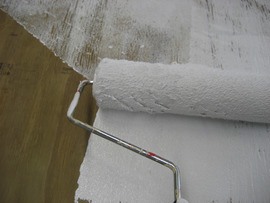 1 Primer: Preparatory coat applied to materials (drywall, wood, metal, etc.) before painting to ensure paint adhesion, extend paint durability, and help seal and protect the surface to be painted
1 Primer: Preparatory coat applied to materials (drywall, wood, metal, etc.) before painting to ensure paint adhesion, extend paint durability, and help seal and protect the surface to be painted
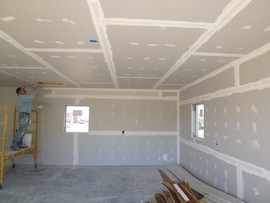 2 Drywall: Type of plasterboard, commonly used to build walls and ceilings, composed of gypsum that is layered between sheets of heavy paper
2 Drywall: Type of plasterboard, commonly used to build walls and ceilings, composed of gypsum that is layered between sheets of heavy paper
How much does it cost to paint a house interior in my city?
Cost to paint a house interior varies greatly by region (and even by zip code). To get free estimates from local contractors, please indicate yours.



